The platform to study rodent behavior (PEC) is a strategic action undertaken by the IN to respond to one of the biggest current challenges in neuroscience: understanding how normal animal behaviors or those that occur in pathological conditions emerge from interconnected neural circuits.

Inside the PEC, the animals are housed in ventilated racks to minimize noise and environmental stress, increasing their well-being and the efficiency and reproducibility of the experiments. In addition, housing in enrichment cages is also available.
The PEC has seven equipped rooms inside the animal facility (RMG), allowing users to explore from the typical behavior of mutant lines and wild types to specific aspects of social behavior, anxiety, depression, sleep, learning, memory, or motor skills. Current equipment includes, among others, Smart V3 video tracking, Erasmusladder, Morris water maze, Phenotyper, touch screen, hot/cold plate, treadmills, and operant boxes for fear conditioning. In addition, four rooms are available outside the RMG, one in the basement and three on the second floor, where users can use their equipment to perform the required animal behavior studies.
SERVICES OFFERED:
- Technical assistance to use the equipment and software available in the service.
- Assistance in the analysis and processing of the data acquired.
- Advice on choosing and/or designing the appropriate behavioral test for the user research and aim.
- Equipment maintenance.
- User guides preparation and assistance in writing materials and methods for publications.
- Organization of specialization courses and workshops.
- Assess and guide in the acquisition of new equipment.
- Participation in outreach activities.
PEC communications will be made through the distribution list:in.pec@listas.umh.es
Please make your inquiry preferably by email to: in.pec@umh.es
Behavioral tests available in the facility:
Learning and memory
- Novel object recognition (NOR)
- Novel object location (NOL)
- Fear conditioning
- Barnes Maze
- Morris water maze
- Y maze
- T maze
- Touch screen
Anxiety, stress and repetitive behavior
- Elevated plus maze
- Light-dark box
- Open field
- Zero maze
- Marble burying
- Nestlet shredding
- Forced swimming test
- Tail suspension test
Sensorimotor
- Cylinder test
- Balance Beam
- Grip Strength
- Wire hang test
- Hot/cold plate
- Olfactory test
- Open field
- Phenotyper
- Treadmill 2 & 5 lines
- Rotarod
- Erasmus Ladder
- qOMR
Social interaction
- 3-Chamber
- Tube dominance
- Intruder test dominance
- Ultrasonic vocalization
- Olfactory habituation and dishabituation
ACCESS REQUIREMENTS
1.- To access the animal facility, you must receive specific biosafety training. The RMG animal facility staff will teach this training upon request to: g.moreno@umh.es.
2.- It is essential to have the function C accreditation (ECC/566/2015) to carry out experiments in the PEC facilities.
3.- The user must be registered at: in.pec@listas.umh.es, through the website https://listas.umh.es/sympa/info/in.pec because the communications regarding the PEC will be made to this list.
4.- The working hours at the PEC facilities are from 8:00 a.m. to 5:00 p.m. Prior notification by email to g.moreno@umh.es and in.pec@umh.es is required to access outside this time or on weekends, as well as register at the concierge desk.
5.- To access and work in the experimental zone, inside the RMG animal facility, it is mandatory to undress and to wear the specific work cloth available at the animal facility changing rooms, as well as a mask, hat, and gloves.
6.- Wear gloves, disposable overshoes and cap, and the lab coat is mandatory to work in room 8 and the second-floor facilities.
7.- It is forbidden to introduce foreign elements into the experimental zone (rooms 1 to 7), including papers/notebooks, pens, mobile phones, headphones, animals, etc.
8.- The platform to study rodent behavior (PEC) has three working areas with different biological safety degrees. Therefore, the workflow must comply with the following restrictions:

9.- It is not allowed to work simultaneously in the PEC and another animal facility (Alberto Sols building) or animal housing room (2nd floor IN). If you have any questions or specific needs concerning this requirement, contact g.moreno@umh.es and in.pec@umh.es.
10.- Hide information from staff may result in restricted access to the PEC facilities, so if you have specific needs, first contact in.pec@umh.es.
RULES
To work at PEC facilities, you must fill out the booking form and make the room booking through the IN website. Only the procedures authorized by the proper authority can be carried out.
The booking holder is responsible for the room and must ensure that everything is tidy and clean after use. Furthermore, in the second-floor rooms, it is not allowed to leave personal equipment or tools without prior authorization from the technical staff in.pec@umh.es).
Noise can affect the results of behavioral tests; therefore, users should carry out the procedures with the doors closed and avoid talking in the corridors.
During your working hours in the PEC room, you have to turn the sign available on the door that indicates “experiment in progress” and turn it again once you leave the room.
It is not allowed to house animals in the workrooms without prior authorization from the technical staff. To request this authorization, you must fill out the available form: temporary housing.
The habituation of the animals to the handling and the room must be done during the booked time and in the same room where the test will be done.
Specific rules for rooms located within the RMG:
- The equipment in rooms 1, 4, 5, and 6 is non-transferable and non-movable. Additional equipment and tools are available in the storeroom and room 2 for use in rooms 2, 3, and 7.
- Equipment cannot be removed or brought into PEC facilities without prior authorization (request to in.pec@umh.es).
- The configuration of the electrical connections in each room is fixed and cannot be modified. If the user needs to connect any other equipment, each room has at least one free plug and power strip. If you need to change the established configuration, please request prior authorization to in.pec@umh.es.
- Each room has non-transferable common-use stuff (paper, ETOH 70%, light, pens, etc.). If any of these components are close to running out or have disappeared, please inform in.pec@umh.es.
- If the behavior test does not allow cages and littermates to be kept in the room (excess noise or odor, etc.), adjoining rooms cannot be booked for animal handling and habituation. In these cases, animals will be transferred directly from the stabling room to the work room using the hood to house each animal individually.
- Files produced during the experiments must be transferred electronically to external computers (by email, Google Drive, Dropbox, etc.). After verifying the reception of the files on the external computer, users must delete the files from the PEC computers.
- Remote connections to PEC computers are permitted unless the room is currently booked.
PEC users are responsible for checking the correct labeling of the animal cages housed in the experimental zone or resonance, updating the procedural code written on the card if necessary, or adding it if it is unwritten.
Any incident must be notified by email to in.pec@umh.es.
BOOKINGS
Only users registered on the PEC distribution list (in.pec@listas.umh.es) will be able to book. Each booking belongs to a single owner and is non-transferable.
PEC rooms can be booked for 2, 3, or 6 hours for up to 4 consecutive weeks through the INTRANET. However, please note that the maximum duration for bookings that block the entire working hours of the rooms inside RMG is two successive weeks, while it is three consecutive days for the rest of the rooms. Contact the technical staff to make bookings that do not fulfill the indicated duration/requirements at: in.pec@umh.es.
It is mandatory to fill out the form available on this website after booking the room on the IN website. Multiple time slots for the same room can be grouped in a single form as long as the same procedure code and cohort are going to be used. Failure to complete this form will render the booking ineffective, and the user will not be able to use the facilities and equipment of the PEC.
The PEC facilities can be accessed Monday to Friday between 8:00 a.m. and 8:00 p.m. However, if you need to use the facilities during the weekend or after 8:00 p.m., you will need to provide prior notification to g.moreno@umh.es and in.pec@umh.es, and register with the concierge.
For any change or booking cancellation, you must write to in.pec@listas.umh.es.
LOCATION
The platform to study rodent behavior (PEC) is located at the Instituto de Neurociencias (Santiago Ramón y Cajal building) and has a spacious work area inside the RMG animal facility with the following equipment:
- Room 1. Erasmus Ladder + qOMR
- Room 2. Videotracking
- Room 3. Videotracking
- Room 4. Morris water maze
- Room 5. Fear conditioning and startle reflex boxes
- Room 6. Phenotype
- Room 7. Video tracking
On the second floor, three other rooms are available for booking, and where it is also possible to work under dim red light. In this area, rooms 1 and 2 can be interconnected to provide more workspace to the users.
Finally, a spacious room is also available in the basement next to the molecular imaging facility (room 8).

Technical head:
Alejandro Sempere – email: a.sempere@umh.es
Animal facility head:
Gonzalo Moreno del Val – email: g.moreno@umh.es
Scientific head facilities PEC:
RMG/Basement: Isabel Pérez Otaño – email: otano@umh.es
Second floor: Felix Leroy – email: fleroy@umh.es
For specific inquiries, doubts about bookings or incidents, please email: in.pec@umh.es.
PEC announcements will be made through the UMH distribution list: in.pec@listas.umh.es.
Contact:
Plataforma para el estudio de la conducta
Instituto de Neurociencias
Universidad Miguel Hernández – CSIC
Av. Santiago Ramón y Cajal s/n
03550 Sant Joan d’Alacant (Spain)
E-mail: in.pec@umh.es
Resp. scientific /technical:
Juan Antonio Moreno
The RMG animal house of the Institute of Neuroscience is a barrier place where the experimental mice are kept in controlled conditions of temperature, humidity, light cycles and SPF. It is divided in two zones: one that is for the breeding and maintenance of the mice and another that is an experimental zone with two operating rooms and seven behavioural boxes. The two operating rooms are fully equipped with all the material needed to perform brain manipulations (electroporations, virus injections) and distinct experimental procedures in mice (surgeries, drugs administration, sampling, weighing, etc). In sum, these rooms have three anesthetic systems by inhalation, two ICUs, scopes, scales to weigh, microcentrifuges, light sources, heating plates, two nanoinjectors, one electroporator and one stereotaxic.
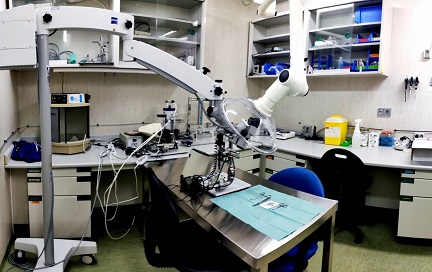

- It is mandatory for new users to receive the corresponding training by the Facility’s personnel before using any of these equipments.
- Working area should be always kept clean, particularly after finalizing the session.
This facility is located on the basement floor of the IN and organized as follows:
- Operating room 1
- Operating room 2
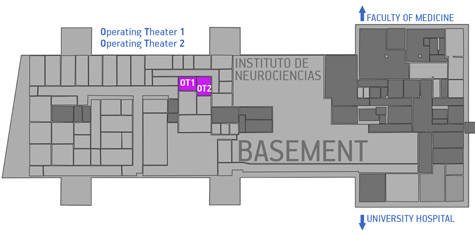
Resp. scientific /technical:
Berta López
1. For the use of the equipment reservation through the intranet of the IN website is necessary: intranet equipment reservation
2. For the common isofluorane anesthesia equipment, there is a maximum of 16 hours allocated per research group at restricted times (9.00 to 18.00).
3. Outside the restricted use schedule, there is no restriction in the reservation of slots although these must be always annotated.
4. Canceling bookings prior to one day can be done through the web page. Cancellations the same day that the equipment is booked must be done by email to in.personal in order to release the slot (mail: in.personal)
5. Working area should be kept clean, particularly after finalizing the session.
6. Any questions, contact the person in charge of the service.
7. Use of the anesthesia equipment:
-Isofluorane tanks must be filled in completely (up to the upper line) once the procedures are finished and every time it is used.
-Users have to fill in the “Isofluorane Use record” with the data required (name, group and time of use) everytime the equipment is used.
-Isofluorane refill records needs to be updated.
-Close O2 tank after using the equipment.
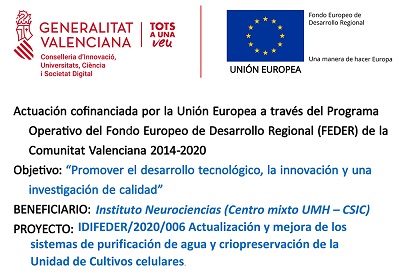
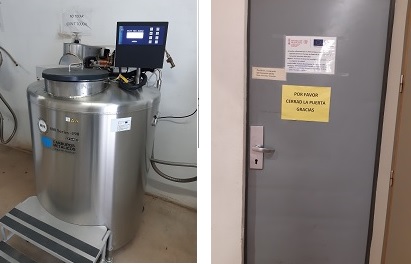
This facility is located in room 105 (First floor).
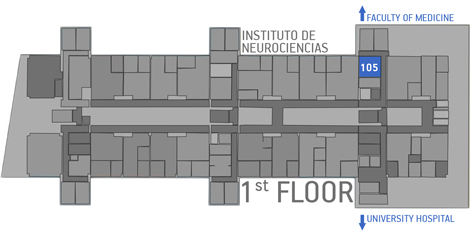
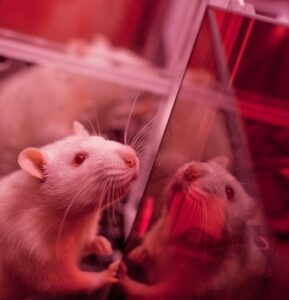
On the second floor of the Institute of Neurosciences is the Area of Behavioural Analysis in Rats, specifically in room 210. This area has a dedicated space to house the animals (see map below), equipped with ventilated racks that guarantee their well-being.
In addition, there is a work area divided into two sections. One is for conducting behavioral tests, and the other is for the experimenter to supervise and control the experiment.
The equipment available in the working area includes:
- Open field maze.
- Elevated plus maze.
- High-resolution camera for movement tracking.
- Automatic lighting control system.
- Rotarod (specifically designed for rats).
- Grip test.
This facility provides a suitable environment to carry out behavioral experiments in rats. In addition, multi-channel electrophysiological and fiber-optic calcium recording equipment can be integrated into the working area to carry out behavioral tests and brain activity recording simultaneously (ask staff).
This facility is designed to operate in a controlled inverse light cycle, and the available illumination is red light (wavelength optimal for behavioral studies in rats). At the entrance to this area, there is a changing room where the necessary personal protective equipment is available for users. Changing clothes is essential to ensure the sanitary integrity of the animals and minimize any interference with their behavior. The top priority is to create a conducive environment for quality scientific research and ensure the welfare of the animals involved in the study.
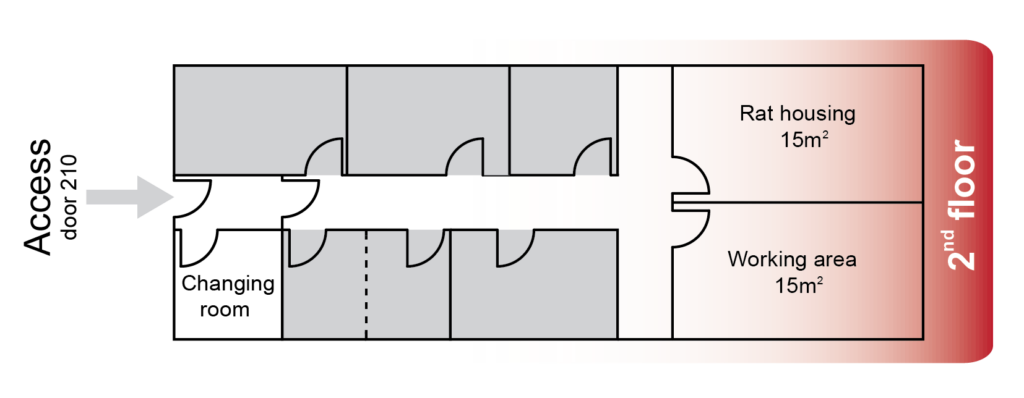
Access requirements
- 1. Specific biosafety training is required to access the Area of Behavioral Analysis in Rats. This training will be given by the animal facility staff upon request by mail to g.moreno@umh.es. In addition, it is essential to have the accreditation of function C (ECC/566/2015).
- 2. New users must receive an introduction to this experimental area code of conduct and organizational rules from facility staff. To request this training, users should email asanz@umh.es. Once both trainings are completed, the user’s IN card will be activated to access the facility.
- 3. To access and work in this facility, it is mandatory to undress and wear the specific clothing for working with rats available in the changing room at the entrance, as well as flat shoes, mask, hat, and gloves.
Rules
It is essential to book in advance by sending an e-mail to scanals@umh.es and asanz@umh.es to access the Area of Behavioral Analysis in rats. This request must specify the date, time, the behavioral test to be performed, and the corresponding procedure code. Only procedures authorized by the competent authority will be allowed.
The booking holder must assume responsibility for keeping the room and equipment in perfect order and cleanliness after use.
- The guidelines listed below must be followed while working in this area:
- Work in an environment of absolute silence.
- It is strictly forbidden to use cell phones within the facility. Mobile devices must be kept in silent mode while in the area.
- Use only the clothing and footwear provided for this area. The shirt and the pants are orange and are available in the changing room. The flat shoes can also be found under the desk in the same room.
- Hang street clothes behind the door in the changing room.
- Ensure that all incoming material meets the highest standards of disinfection and cleanliness.
Minimize the use of white light in this area because the animal’s environment is in reverse cycle.
Any incident must be notified via e-mail to asanz@umh.es and/or scanals@umh.es
Scientific head:
Santiago Canals Gamoneda – scanals@umh.es
Technical staff:
Aroa S Maroto – asanz@umh.es
Resp. scientific: Sandra Jurado
Technical staff: María Pérez
The surgery service located at room 227 (2nd floor) provides a dedicated space and the necessary equipment to perform surgical interventions in murine animal models (rats and mice). The service is primarily dedicated to in vivo intracranial injections (stereotaxic injections) of viral particles, but it is also available for cell, drug and intraperitoneal injections and microsurgeries among other procedures.
The surgery room provides the following services:
- Room equipped with surgical table, stereoscope, and animal recovery chamber with adjustable temperature
- Stereotaxic frame adaptable for mice and rats (Kopf) and accessories
- Isoflurane vaporizer
- Oxygen concentrator
The room and the equipment can be booked independently, since most of equipment can be taken out to perform procedures at individual laboratories.
Room and equipment booking must be done via intranet at: user access.
Please keep in mind that you should do independent bookings for the room (Cirugía) and the required equipment. The options are listed below:
- Cirugía
- Cirugía-concentrador de oxígeno
- Cirugía-Estereotáxico
- Cirugía-Isoflurano
New users should contact Dr. Sandra Jurado: sjurado@umh.es to receive a brief training and get familiar with the user guidelines. This first contact is mandatory to gain access to the surgery room.
For any inquiries or incidences with the facility, contact Dr. Sandra Jurado: sjurado@umh.es

 Español
Español